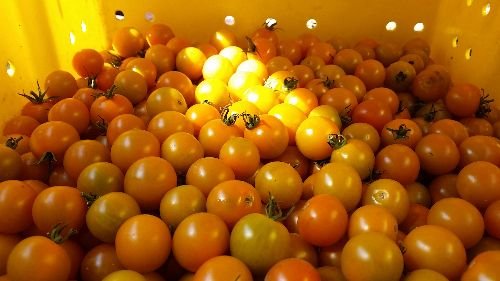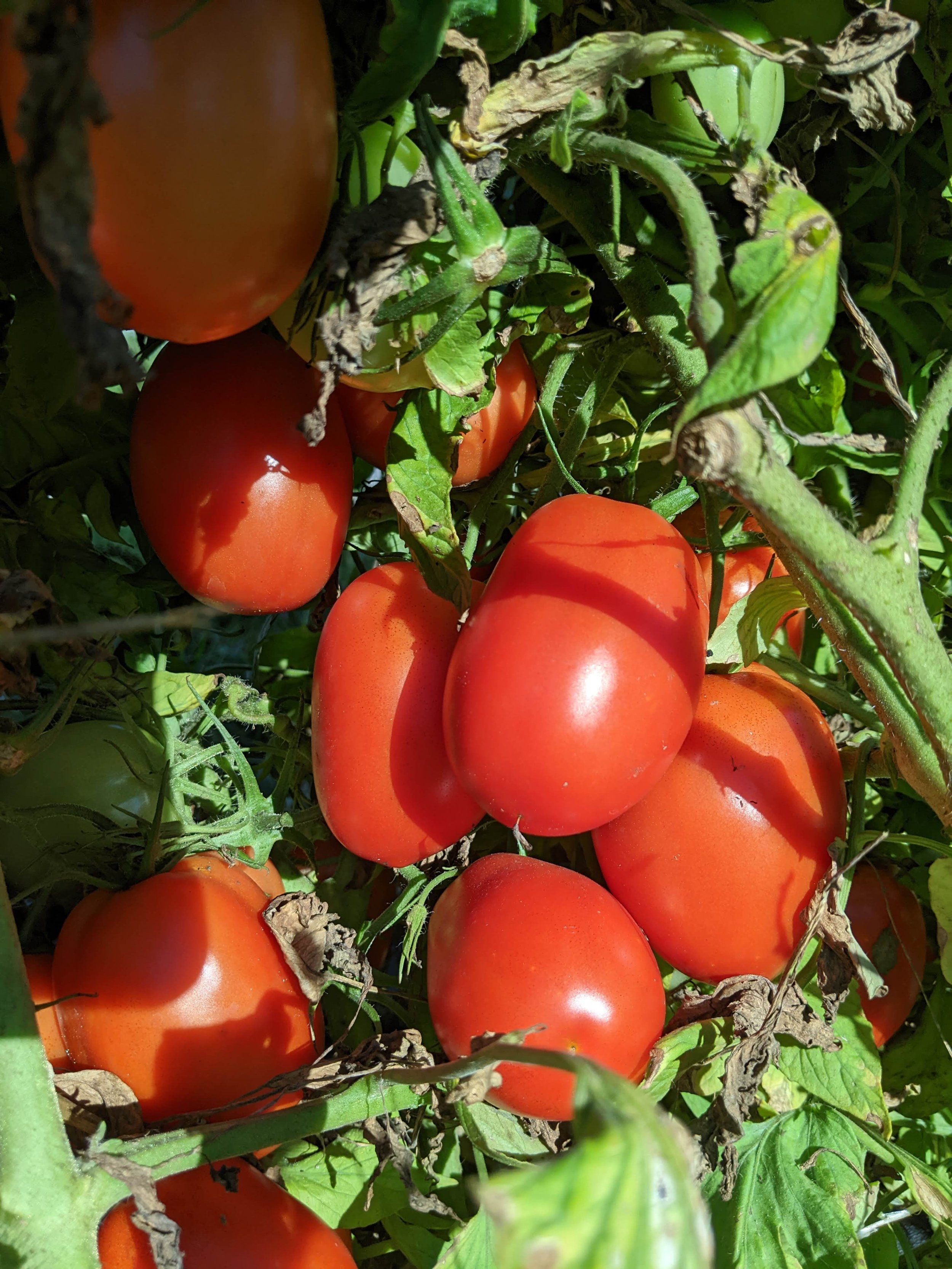


Tomatoes, Tomatoes, Tomatoes!
We specialize in growing tomatoes, mostly heirloom varieties. When Kate began farming in 2008, she started 300 heirloom tomato plants under fluorescent lights in her basement. This was back in the days when we farmed in local yards and didn't have a greenhouse. Kate couldn't resist the variety of flavors, colors, shapes and sizes of the heirloom tomatoes in the seed catalog, so she bought them all. Since then, she's tracked down dozens more varieties and has added to the list every year.
If you want the absolute freshest, ripest and most delicious tomatoes, either seek out a local farm, or better yet, grow them yourself! Here we will share information about all different types of tomatoes along with types on how to successfully grow them yourself!
Key Terms To Familiarize Yourself With
An heirloom tomato is an old fashioned variety. If you plant the seeds, they'll produce the same kind of tomato. They "breed true" and have been doing so for at least 50 years. These varieties weren't bred for looks, but rather for their distinctive flavors and to perform well in the growing conditions of their native region. Once upon a time, New Englanders grew different tomato varieties than Texans or Italians or Russians. As a result, there are hundreds and hundreds of heirloom tomato varieties, many with quirky names like Aunt Ruby's German Green or Cosmonaut Volkov, and they are often called "ugly" because of their weird shapes and color patterns.
Open Pollinated tomatoes are a close cousin to heirloom tomatoes. They breed true from seed, but they haven't been doing so for 50 years yet. Pink Berkely Tie Dye is a great example. It is an open pollinated tomato that has been breeding true for about 10 years. Most people give it the benefit of the doubt and grant it full heirloom status, but technically, it's not there yet.
Hybrid tomatoes don't breed true from seed because they have two different varieties of tomatoes as parents. Hybrids aren't genetically modified, they come from traditional plant breeding techniques – taking pollen from one variety and putting it on the flower of another variety. Normally tomatoes are self fertile, meaning the flowers pollinate themselves. This is why heirlooms and open pollinated varieties breed true from seed without any work on our part. Sometimes bees or wind can create unplanned hybrids, but generally the flowers pollinate themselves before that can happen.

More To Know About Hybrids, Seed Saving & Flavor
You can't save your own hybrid tomato seeds - you have to buy new ones each year because you usually don't know the varieties of the parents - which you would need to create your own crosses. If you save seed from a hybrid tomato, you might get something wonderful, but it won't be quite the same as the parent plant. Some hybrids are phenomenal and we grow a number of them (Sungold cherry tomatoes anyone?). They are often strong plants exhibiting “hybrid vigor”. All the hybrids we offer have been selected for overall awesomeness.
However, many varieties of hybrid tomatoes are not bred for flavor, or overall awesomeness, but rather so that they can be shipped cross-country and ripen after they are harvested. They are bred to be the same shape and size (easy to pack!), and to have a generic tomato "look." As large scale, commercial agriculture became widespread, new hybrid varieties of tomatoes were bred that were more suitable for this type of farming. Some of these new hybrid tomatoes replaced the heirloom varieties in most markets, because they are easier for growers, packers, shippers, and store owners. Many taste bland with a disappointing flavor and texture - nothing like a fresh heirloom tomato.
Luckily, small farmers, gardeners and seed savers hold on to heirloom and open pollinated seeds. They grow them year after year and pass them around to other growers. A network of small, heirloom growers have hung around, and now people are rediscovering heirloom tomatoes and other wonderful heirloom vegetables.
If you buy heirloom tomatoes from the grocery store they probably aren't going to taste like the heirloom tomatoes you pick from your garden or buy from the farmers market. The big stores are aware of the heirloom marketing niche and are trying to fill it with produce that (usually) had a long journey before it reached you. To ship heirloom tomatoes long distance, growers must pick them long before they are ripe, and let them ripen en route. This doesn't allow the tomatoes to develop their flavor like they would if they were left on the vine longer. Those extra days on the vine make a world of difference.
If you want the absolute freshest, ripest and most delicious tomatoes, try growing them yourself! You can grow tomatoes in your garden or in a pot on the deck or front steps. They are one of the most rewarding crops in the garden. Tomato tips are included below to help you along the way.
Grow Your Own Tomatoes
Step One: Deciding On The Type Of Tomato(es) To Grow
Are you container growing or planting directly into the ground?
Most varieties of tomatoes grow into very large plants. Some varieties will grow taller than 7 feet. However, there are some varieties of tomatoes that are bred to stay very small and to fit into 5 gallon containers or smaller. Check out the “Container Tomatoes” listed on our Seedlings 2024 page as a reference for smaller variety tomato plants.
Do you want one big tomato harvest, or would you like tomatoes all season long?
Determinate varieties of tomatoes won't grow as large - they usually top out at around 4 feet. However, they also ripen their fruit more or less simultaneously - generally over a 2 week period. Many sauce tomatoes are determinate varieties allowing for one big harvest so you can make a lot of sauce all at once.
Indeterminate varieties of tomatoes will usually bear fruit from late July or early August until the first frost. These plants just keep on growing until the cold temperatures kill them. They can get really big, so plan for trellising accordingly!
Step Two: Prepare Your Space
If you’re planting into the ground, plant tomatoes into rich, well drained soil in your garden. To improve your soil and provide more nutrients for the plants, we recommend adding organic compost before planting. Mix it into the soil before you plant.
If your planting into a container, The bigger the container, the better! Too small a container and the plant will struggle, possibly bearing little to no fruit. A single tomato plant will easily fill a 5 gallon container. Regardless of the size, fill your container with a high quality, organic compost based potting mix.
Step Three: Planting!
Don't plant your tomatoes until the temperature remains well above freezing every night, preferably not dropping below 50. Sometime between Mothers' Day and Memorial Day weekend is usually safe.
When you plant your tomato, dig a hole that is about 3 or 4 inches deeper than it looks like you need. Along with the roots, bury part of the stem in the hole. The tomato will grow new roots from the part of the stem that is now underground, and that will make it into a healthier, more productive plant. If you're tomato is really tall and leggy, bury it even deeper, it'll love it – really!
After you plant your tomatoes, you will need to water them. Give each plant AT LEAST 1 quart of water after planting. You can use plain water or you can mix up a weak solution of fish and kelp emulsion (we recommend Neptune's Harvest Blend - it's organic and it's made in Gloucester). Read the instructions on the bottle for the mixing ratio, and use the mixture to water the tomatoes after you've transplanted them. Don't make the solution very strong - you don't want to shock them, you're just giving them a little boost.
Give each plant another quart of water the following day.
Step Four: Maintaining Your Tomato Plant(s)
Water your tomatoes (with 1 quart of water) 3 or 4 times a week (unless we've had a heavy rain). As the plants grow, you may need to give them a half gallon of water (or more!) each time you water. If you see droopy, wilting leaves, your plant is probably too dry. Tomatoes prefer to be watered heavily a few times a week, rather than getting a little bit of water every day.
Fertilize your tomatoes throughout the season to keep them healthy and productive. As always, we recommend staying organic and avoiding synthetic fertilizers. We love using Neptune's Harvest Fish and Seaweed liquid fertilizers. These are great organic fertilizers for tomatoes and everything else. We usually fertilize every few weeks, but you should follow the directions on your package.
Most varieties of tomatoes grow into very large plants. Some varieties will grow taller than 7 feet. The plant will need support to keep it from tipping over and trailing along the ground. Use tomato stakes and string, or metal tomato cages, or large branches, or a trellis to keep your plants upright. Think tall! It is easier to start out with tall stakes or cages in the beginning.
Step Five: Harvesting!
When it's time to harvest them, don't let them get too ripe on the vine or you won't be able to slice them. Many heirloom varieties are fully ripe when the area around the stem (the "shoulders") is still green. Keep an eye on the color at the base of the tomato. When the color at the base is really deep and saturated, your tomato is probably perfectly ripe.
Step Six:
Fresh tomatoes, even homegrown, can still be ruined once their off the vine. (Hint: Don't put your tomatoes in the refrigerator!! They will lose much of their flavor and their texture will change)
To keep tomatoes in your house before eating, leave them on the counter, out of the sun. We wrap them in a paper towel or thin tea towel to keep fruit flies at bay and to allow them to breathe. If you put them in a plastic bag, any excess moisture is trapped and they tend to get mushy and moldy more quickly. If you are choosing tomatoes and you don't want to eat them for a few days, pick the ones showing a little less color saturation at the base.




